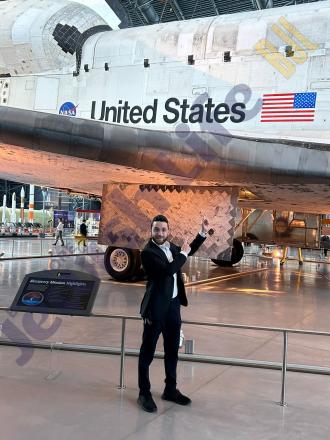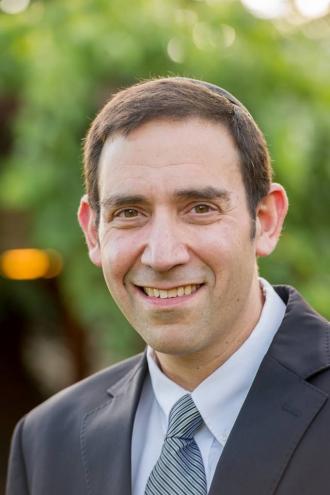Ever since he can remember, Boris Ramatsky has known the old wooden building with Stars of David over its windows in the center of Tomsk, Siberia. He’d pass it on his way to and from school as a child, and then to and from work as an adult. No plaque marked the structure as the Soldatskaya Synagogue, or Soldiers’ Synagogue, built by Jewish former child soldiers of the Czar’s army, nor its confiscation by Soviet authorities in 1930.
Like most other aspects of Jewish life in the Soviet Union, the history of the synagogue lurked in the shadows of memory.
“It wasn’t allowed to be spoken of, and so the adults tried not to say too much,” says Ramatsky. “But when we passed it, we always knew.”
Ramatsky’s grandfather, Menachem Yosef Ramatsky, arrived in the city of Tomsk with his family from Poland as a refugee during World War I. He later became the Soldatskaya Synagogue’s shammes (caretaker), watching over it until the day in 1930 when authorities evicted the faithful and turned the building into a dormitory for researchers at Tomsk State University.
Built in 1907 by former Cantonists—Jewish men who had been kidnapped as young children and forced to serve in the Czar’s military for 25 years—the wooden structure tells the story of one of the most horrific chapters in Russian Jewish history, when, beginning with Czar Nicholas I’s 1827 Statute on Conscription Duty, thousands of Jewish children were kidnapped from their homes and forced to serve in the Imperial Military. A program of coerced conversion was part and parcel of the conscription decree, although against all odds a majority of the child soldiers did not in fact abandon the faith of their fathers.
Tomsk’s Soldatskaya Synagogue is possibly the last extant such synagogue constructed of wood, having survived fire, revolution, confiscation and post-Soviet urban renewal amid the Siberian frost. In 2013, local authorities in Tomsk—a city of about 500,000 people some 2,200 miles east of Moscow—pledged to return the building to the Jewish community, an agreement that was just honored. On Feb. 1, in a ceremony attended by Russian Chief Rabbi Berel Lazar, Tomsk’s chief rabbi and Chabad-Lubavitch emissary Rabbi Levi Kaminetsky and local dignitaries, city officials formally returned the Soldatskaya Synagogue to the Jewish community of Tomsk.
Both Lazar and Kaminetsky point out that handing the structure over was not as simple as it might sound, crediting Tomsk city and regional authorities for the work they did to make it happen. Years ago, the synagogue building was converted into apartments, and despite its dangerously dilapidated condition, was until recently inhabited by 17 families, all of whom shared a single communal kitchen. In the last few years, Tomsk city officials have worked to relocate the inhabitants into newer and safer quarters; when that was complete, they turned the structure over to the Jewish community.
Led by Kaminetsky, Tomsk’s Jewish community already has a beautiful and renovated synagogue, and is in mid-construction of a Jewish community center. Plans for the Soldiers’ Synagogue have not yet been finalized, but the building’s importance and symbolism are not lost on Russia’s Jewish community.
“This building is really a story of gevurah, of Jewish strength,” explains Lazar. “That they were disconnected from the Jewish community, stayed in Siberia, but still went through this effort to build a synagogue for themselves, really says a lot about the type of Jewish education they received at home. When you compare their circumstances to the ones of today—when it’s easy to be Jewish—it really makes you think about all of the work that needs to be done to give everyone the opportunity to be a part of the Jewish community, wherever they may be.”
Survival in the Czar’s Army
Although the Cantonist decree drafting children was formally rescinded in 1856 (remaining in effect until 1859), the Jews were still actively drafted into the Imperial Military, where pressure on them to convert to Russian Orthodoxy remained. Various measures were employed to coerce or even force Jewish soldiers to convert. Yet even among those who would convert, when the times or their positions in life changed, there were flurries of renouncements made at later dates. It was only in 1905 that Nicholas II issued a decree stating that soldiers who had converted to Russian Orthodoxy, though still professed the “non-Christian religion to which they or their ancestors belonged before Orthodoxy,” were free to revert to their previous religion, if they so desired.
Among the most famous and impactful advocates for the rights of Jewish Cantonist soldiers was Rabbi Menachem Mendel of Lubavitch (1789-1866), known as the Tzemach Tzedek. The Jewish soldiers were often viewed with suspicion by Jewish communities, sometimes forcing them to create their own communities and synagogues upon their gaining freedom—the Tomsk synagogue an example of this tragic phenomenon. The Tzemach Tzedek not only battled Russian authorities on their behalf, but insisted that the Jewish community treated them with dignity, even the utmost respect. In 1827, he established an organization called Chevras Techiyas Hameisim, which used any and all means to try to assist or free these children, paying bribes when possible and attempting to stop the khappers [“grabbers”], the men who would kidnap the children. In one case, he even delivered a Chassidic discourse for Jewish soldiers stationed at Kronstadt, the seat of the Russian admiralty, near the Imperial capital of St. Petersburg, a story retold by his successor and namesake—the Rebbe, Rabbi Menachem M. Schneerson, of righteous memory.
In 1845, Chaim Yehoshua of Kalisk, a Chassid of the Tzemach Tzedek, was caught in the act of ransoming a few Cantonists in the village of Kastoreve, near Kazan in central Russia. Imprisoned under harsh conditions, the regional governor wanted him tried for treason. A letter from the Tzemach Tzedek to another one of his followers addresses Chaim Yehoshua’s arrest in veiled terms, and can be read here, with explanation and annotation provided by the sixth Rebbe, Rabbi Yosef Yitzchak Schneersohn, of righteous memory.
Tomsk’s Soldatskaya Synagogue’s history begins with a figure named Herzl Yankelovich Tsam, who, according to a 2008 article in the Russian-language Jewish literary magazine Lechaim, was one of the only Jews in the 19th century to become an officer in the Imperial Military, the only one to reach the rank of captain. Tsam was 8 or 9 years old when he was kidnapped in 1852 and sent to a Cantonist School. His first years in military captivity were spent in the heavily Jewish Vohlynia region of what is today Ukraine, where he had been born and snatched; later, he was sent together with a group of Jewish soldiers to Tomsk.
According to Tomsk Jewish historian David Kuzhner, Tsam recorded in his memoirs that of all the Jewish soldiers in Tomsk, only about 50 of them did not convert. Sadly, the Soldiers’ Synagogue’s history dates to an affront. A son was born to one Jewish soldier, Moshe Gurevitch, and on Shabbat he and a number of fellow soldiers came to a community synagogue for Gurevitch to be called to the Torah, as is tradition. One synagogue official insisted that the group not enter the sanctuary and remain in the hallway. Then and there the soldiers decided they would start their own minyan.
They collected money amongst themselves for a Torah scroll, which was completed in 1865, and began praying at a temporary location. In the early 1870s, they purchased land, and Tsam, who, despite his high rank would over 41 years in the military maintain fealty to his Judaism, donated funds for the construction of a synagogue. In 1906, this building was badly damaged by fire, and the community decided to rebuild and expand it into what would become the new Soldatskaya Synagogue, opening in August of 1907.
‘A Real, Miraculous Rebirth’
Minus three domes that once graced it, this is the building that was handed over last week to the Tomsk Jewish community.
“So many of the synagogues here in the former Soviet Union were built by Jews of means,” says Lazar. “They are massive buildings, constructed with marble in the center of the city. Here you see people who were rejected, did not have a lot of money, but still went to every length to build themselves a synagogue. You can see the mesirus nefesh—the self-sacrifice—in the walls of the building where they prayed.”
On the day of the return a celebratory banquet was held in the city’s main Choral Synagogue, attended by Lazar, Kaminetsky and dignitaries, during which Ramatsky, who is the chairman of the Jewish community, surprised the celebrants with one more gift.
“Boruch [Ramatsky’s Jewish name] unwrapped a Torah scroll, still in its original covering with Hertzl Tsam’s initials written on it, which came from the Soldatskaya Synagogue,” says Kaminetsky. “His grandfather had hidden it, his father Avraham kept it, and until now, Boruch had it.”
Kaminetsky and his wife Gitty have been working to rebuild Jewish life in the Siberian city since their arrival in 2004. Like everyone else in Tomsk, he was aware of the Soldiers’ Synagogue, but did not dream it would ever be given back. He knew nothing about the Torah scroll.
Kept hidden from the world for 88 years, the soldier’s Torah scroll, a link in the chain of the Soldiers’ Synagogue and of Tomsk’s Jewry, was finally back with the community and will one day return to its original home.
“The returns are a sign,” explains the rabbi. ”What we’re experiencing here is a real, miraculous rebirth.”
Ramatsky points to the 150 people who came out to the ceremony despite the sub-zero temperature, visibly celebrating the moment. “People should know that there are still Jews in Siberia,” he says, “and Jewish life here is growing.”

















